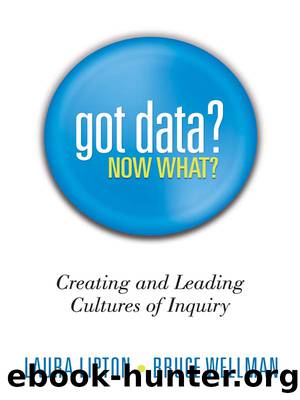Got Data? Now What? by Lipton Laura;Wellman Bruce;

Author:Lipton, Laura;Wellman, Bruce;
Language: eng
Format: epub
Publisher: Solution Tree
Published: 2012-08-15T00:00:00+00:00
Source: Adapted from Wellman & Lipton, 2004.
Surveys
As with interviews, surveys also provide an effective method for collecting both behavioral and perceptual information. Researchers most commonly use two primary survey categories: (1) scaled and (2) unscaled.
1. Scaled surveys: A scaled survey asks respondents to quantify their answers and provides information that is readily organized graphically. However, these responses are often limited in scope. For example, a response of 4 to the question, âOn a scale of 1â5 how would you rate the effectiveness of this program?,â does not offer information on what constitutes a 4 for this respondent, or what might have made it a 5.
2. Unscaled survey: Unscaled surveys usually require responses to open-ended questions. Compared to scaled surveys, these instruments yield more potential information, but are more complex to organize for analysis. For example, a question might read, âIn what ways did this program meet your expectations?â These qualitative data are most often organized into tables or charts based on emerging categories.
Creative Research Systems (2011) offers five basic steps to survey design.
1. Establish the goals of the project: Determine what you want to learn or know more about.
2. Identify your sample: Determine who will participate in the survey.
3. Choose survey methods: Design how you will gather the information (interview or written response).
4. Create your questions: Decide what you will ask and in what ways. See Types of Survey Questions (page 72) for examples. (Visit go.solution-tree.com/teams to download the reproducibles in this book.)
5. Pretest or pilot the survey: This optional step, if practiced logistically, is useful for testing the questions, protocol, or both.
Feasibility
Feasibility is the term for how realistic and reasonable it is to collect and apply a data source. The realities of life in schools create a critical need for making effective and efficient choices. Time, money, energy, and even space come into consideration in making choices about what data to collect. One tip is to look first to archival data, those things that teachers, schools, and districts are already collecting and have readily available. After tapping archival resources, groups can make creative and selective choices identifying additional collectibles that will illuminate, detail, and complement the existing data.
Archival Data
Archival data are those that already exist and are accessible, often electronically, as part of the districtâs established information base. These can be both quantitative and qualitative sources. Archival data include student performance dataâsuch as test results, grades, referral, suspension, and retention ratesâand demographic dataâsuch as percentage of students in particular programs; race, ethnicity, and gender profiles; attendance rates; and socioeconomic status (for example, numbers of students receiving free or reduced lunch). Demographic data for staff might include years of experience, types of certification, and levels of education. Mobility rates can be accessed for students, staff, and administration.
Much archival data have an anthropological quality and include sources that offer insight into the day-to-day life in the district, school, or classrooms. These data include correspondence such as memos, newsletters, bulletins, and meeting minutes; descriptions of course offerings; and available extracurricular activities. Per-pupil expenditures and other budget information fit this category, as well.
Download
This site does not store any files on its server. We only index and link to content provided by other sites. Please contact the content providers to delete copyright contents if any and email us, we'll remove relevant links or contents immediately.
Macmillan Primary Grammar 2 Pupil's Book by Unknown(392)
Figuring Out Fluency in Mathematics Teaching and Learning, Grades K-8 by Jennifer M. Bay-Williams & John J. SanGiovanni(356)
The Principal's Guide to Curriculum Leadership by Sorenson Richard D.;Goldsmith Lloyd M.;Mendez Zulma Y.;Maxwell Karen T.;(285)
Learning from Accidents 3rd ed by Trevor Kletz (2001)(245)
English Grammar Practice--The Noun by Roxana Nastase(243)
Harnessing Technology for Deeper Learning by Scott McLeod(235)
Text-Dependent Questions, Grades K-5 by Douglas Fisher & Nancy Frey & Heather Anderson & Marisol Thayre(219)
A Guide to Curriculum Mapping by Hale Janet A.;(218)
English Language Program Administration by Unknown(209)
How to Do Everything with Google Tools by Unknown(203)
Deep Change Leadership by Reeves Douglas;(198)
The Grammar Teacher's Activity-a-Day by Jack Umstatter(187)
The Power of SMART Goals by Conzemius Anne;O'Neill Jan; & Anne Conzemius(186)
Aligning and Balancing the Standards-Based Curriculum by Squires David A.;(166)
Beyond the RTI Pyramid by Bender William N.;(165)
Using Data to Close the Achievement Gap by Johnson Ruth S.;(160)
Differentiated Instructional Strategies for the Block Schedule by Gregory Gayle H.;Herndon Lynne E.; & Lynne E. Herndon(158)
Using Equity Audits to Create Equitable and Excellent Schools by Skrla Linda E.;McKenzie Kathryn B.;Scheurich James Joseph;(156)
You've Got to Reach Them to Teach Them by Schreck Mary Kim; & Schreck(148)
